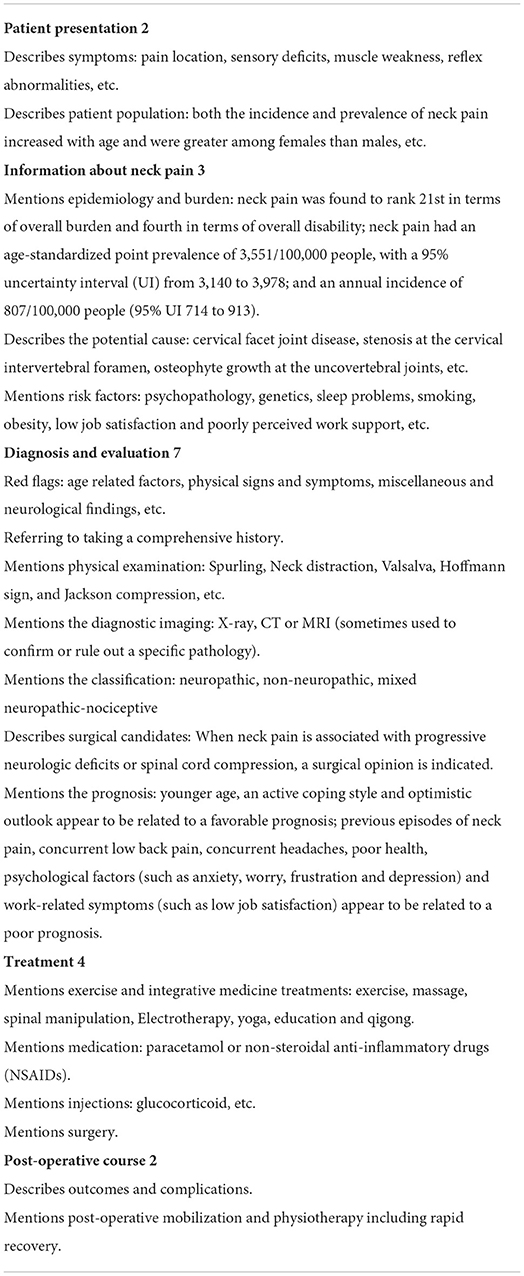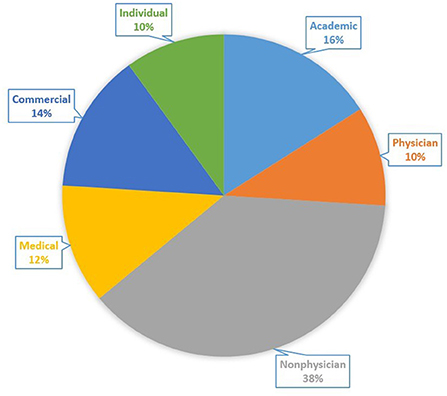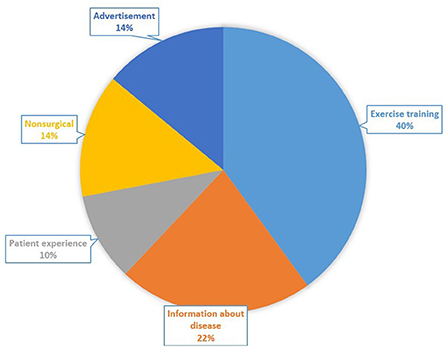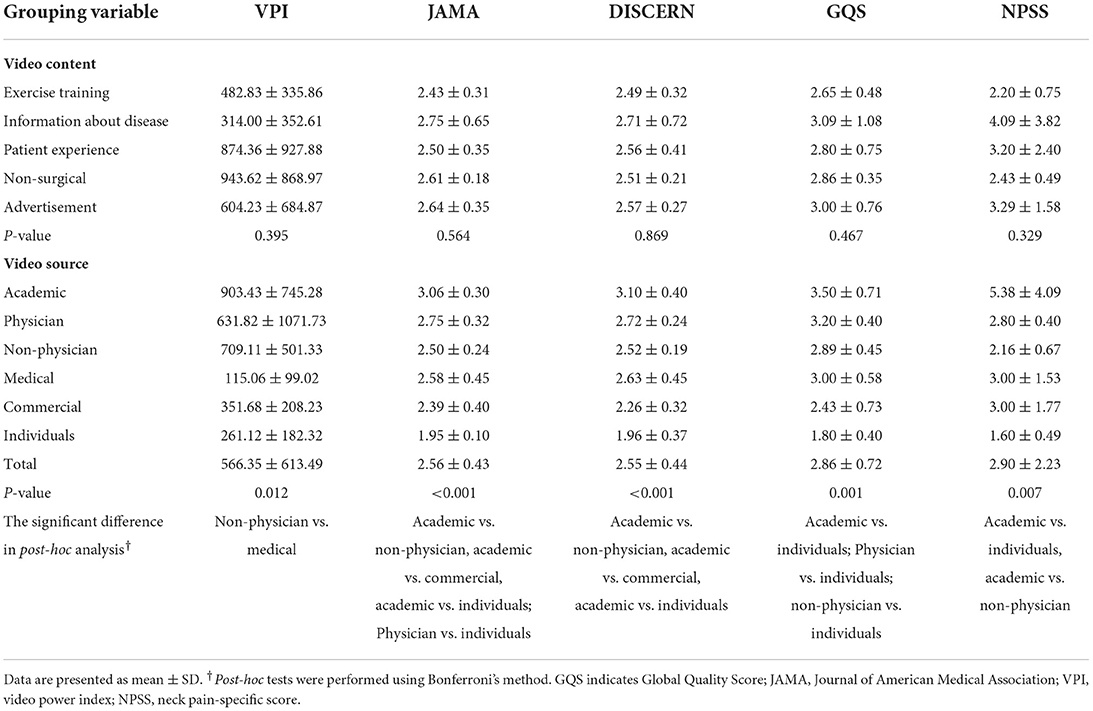- Department of Orthopedics, Orthopedic Research Institute, West China Hospital, Sichuan University, Chengdu, China
Background: More than 70 percent of the world's population is tortured with neck pain more than once in their vast life, of which 50–85% recur within 1–5 years of the initial episode. With medical resources affected by the epidemic, more and more people seek health-related knowledge via YouTube. This article aims to assess the quality and reliability of the medical information shared on YouTube regarding neck pain.
Methods: We searched on YouTube using the keyword “neck pain” to include the top 50 videos by relevance, then divided them into five and seven categories based on their content and source. Each video was quantitatively assessed using the Journal of American Medical Association (JAMA), DISCERN, Global Quality Score (GQS), Neck Pain-Specific Score (NPSS), and video power index (VPI). Spearman correlation analysis was used to evaluate the correlation between JAMA, GQS, DISCERN, NPSS and VPI. A multiple linear regression analysis was applied to identify video features affecting JAMA, GQS, DISCERN, and NPSS.
Results: The videos had a mean JAMA score of 2.56 (SD = 0.43), DISCERN of 2.55 (SD = 0.44), GQS of 2.86 (SD = 0.72), and NPSS of 2.90 (SD = 2.23). Classification by video upload source, non-physician videos had the greatest share at 38%, and sorted by video content, exercise training comprised 40% of the videos. Significant differences between the uploading sources were observed for VPI (P = 0.012), JAMA (P < 0.001), DISCERN (P < 0.001), GQS (P = 0.001), and NPSS (P = 0.007). Spearman correlation analysis showed that JAMA, DISCERN, GQS, and NPSS significantly correlated with each other (JAMA vs. DISCERN, p < 0.001, JAMA vs. GQS, p < 0.001, JAMA vs. NPSS, p < 0.001, DISCERN vs. GQS, p < 0.001, DISCERN vs. NPSS, p < 0.001, GQS vs. NPSS, p < 0.001). Multiple linear regression analysis suggested that a higher JAMA score, DISCERN, or GQS score were closely related to a higher probability of an academic, physician, non-physician or medical upload source (P < 0.005), and a higher NPSS score was associated with a higher probability of an academic source (P = 0.001) than of an individual upload source.
Conclusions: YouTube videos pertaining to neck pain contain low quality, low reliability, and incomplete information. Patients may be put at risk for health complications due to inaccurate, and incomplete information, particularly during the COVID-19 crisis. Academic groups should be committed to high-quality video production and promotion to YouTube users.
Introduction
Neck pain imposes a substantial economic burden on patients and renders them handicapped (1–5). More than 70 percent of the world's population is tortured with neck pain more than once in their vast life (6, 7), of which 50–85% are expected to recur within 1–5 years of the initial episode (7). Neck pain occurs more frequently in females than males, peaking in middle age (6, 8, 9). Neck pain is strongly associated with multiple comorbidities, including depression, headache, joint pain, and back pain (8, 9). Moreover, neck pain also poses a huge economic burden to society, including the costs of treatment, lost productivity, and job-related problems (10).
Classifying neck pain as neurotic or non-neurotic is critical and urgent, as this information is required to guide investigation (imaging necessity) and treatment decisions (11). There are many potential diagnoses for neck pain, but common ones include myofascial pain, degenerative disc disease, and muscle spasms (12). Since the prognosis of neck pain is closely related to duration (13, 14), it is important to identify patients in time and to have them receive appropriate health education and proper management.
Unfortunately, the current COVID-19 pandemic and concomitant restrictions have contributed to a severe shortage of conventional medical care (15–18). Given the explosive growth of the Internet as a source for quick and extensive information in all areas of life, 80% of netizens have searched the Internet for health information (19), and up to 30% of orthopedic patients have searched for medical information online (20), which has greatly facilitated consultation and medical treatment during the epidemic. With more than 1 billion visitors per month, YouTube boasts one of the most popular and dominant websites for viewing and sharing videos on the Internet (21, 22). Patients can use YouTube to gain health-related medical knowledge and use publicly accessible YouTube video-based tutorials to treat their conditions, especially during the current pandemic (21, 23, 24). However, while some of the high-quality orthopedic content on YouTube is uploaded by qualified specialists, it is undeniable that the majority of videos are still uploaded by unqualified individuals, and most of the videos are not peer-reviewed, resulting in the dissemination of inaccurate, incomplete, and low-quality videos. Given the lack of control mechanisms and uneven quality of uploads, there is a considerable risk of getting misleading or insufficient information on health-related issues (25, 26).
To the best of our knowledge, there currently exist no studies evaluating the reliability and quality of YouTube videos providing medical information to patients with neck pain. Especially against the backdrop of the COVID-19 pandemic, assessing the quality of the relevant videos regarding neck pain is crucial to determining the potential applicability of YouTube tutorials. This article aims to assess the quality and reliability of the medical information shared on YouTube regarding neck pain and to identify factors associated with the overall video quality or reliability.
Materials and methods
Recruitment
In this cross-sectional study, we used the search item “neck pain” on YouTube (accessed on 25 May 2022) and designed to include relevant videos for patients with neck pain. Search history records were deleted before the search to reduce the impact on search results. In over 50,000 search results, the top 50 videos by relevance were recorded for evaluation, which has been widely adopted as a feasible method of video selection in the literature within orthopedics (27–29). Additionally, the purpose of this study was to simulate and analyze the results viewers come across on visiting YouTube for medical information from a researcher's perspective, rather than to assess all the videos uploaded on YouTube regarding neck pain. Most YouTube viewers will not watch more than the first two pages of search results found online (30). On this basis, above YouTube video studies within orthopedics have examined small subsets of videos (50 videos) and similar statistical analyses were conducted. Therefore, we included the first 50 results for further evaluation. All videos were about neck pain and were in English.
Collection of video features and source
The following information was recorded during screening: (1) Title, (2) number of views, (3) number of likes, (4) number of dislikes, (5) video duration, (6) comments, (7) number of subscribers, (8) time since upload and (9) Video Power Index (VPI). The formula for calculating VPI is as follows: [(likes × 100/(likes + dislikes)) × (views/day)/100]. The index used to assess viewers engagement and video popularity has been successfully applied to previous research (28, 31, 32).
According to previous studies (27, 28, 31), the videos were categorized into six groups based on their source: (1) academic (authors were affiliated with universities or research groups or colleges), (2) physician (authors were professional physicians with no affiliations), (3) non-physician (health professionals other than licensed physician: physiotherapists, and occupational therapists), (4) medical (contents from health websites), (5) commercial and (6) individuals. The categories are as follows according to content (1) exercise training, (2) information about disease, (3) patient experience, (4) non-surgical, and (5) advertisement according to previous studies. When the videos have more than one topic, we typically evaluate and identify the topics that patients will gain the most from the video. The duration of the topic, the amount of information contained, and the comments of the viewers are all important evaluation indicators.
Assessment of reliability and quality
The accuracy and reliability of videos were assessed with the Journal of American Medical Association (JAMA) benchmark criteria, provided by Silberg et al. (33) (Table 1). The JAMA total score is calculated by assigning 1 point for the existence of each criterion. A score of 0 indicates low video quality and accuracy, while a score of 4 indicates high video quality and accuracy. The educational value of each video was scored using a 5-point global scale [recorded as the Global Quality Score (GQS)] modified from Singh et al. (34) (Table 2). GQS score ranges from 1 to 5, with higher scores indicating better quality of education. Additionally, a modified DISCERN tool, similar to the five-point evaluation tool reviewed by Kocyigit et al. (24), was used to evaluate the reliability of the included videos. It contains five binary yes/no questions, each positive yielding 1 point, with a maximum score of 5 (Table 3).
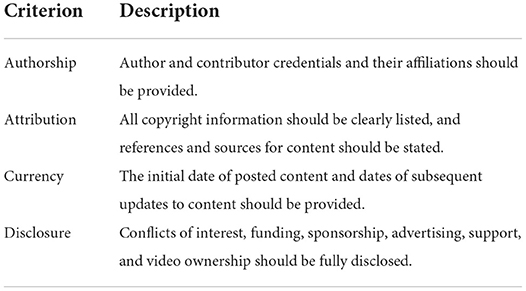
Table 1. Journal of the American Medical Association benchmark criteria (33).
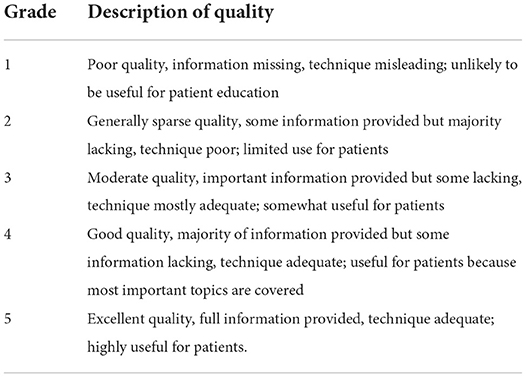
Table 2. Global Quality Score criteria (34).
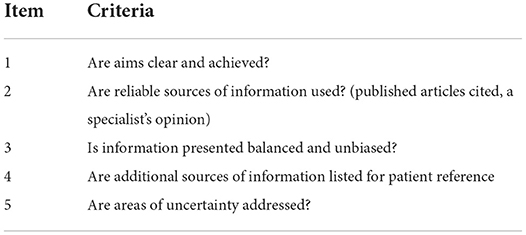
Table 3. 5-point DISCERN criteria (1 point for each item; a total of 5 points) (24).
Since no assessment tool exists to comprehensively assess the educational content of neck pain, we created a new grading criteria [called the “Neck Pain Specific Score” (NPSS)] based on literature review and expert opinion (5, 10, 11, 35–39). The NPSS specifically assesses educational content on (1) patient presentations, (2) information about neck pain, (3) diagnosis and evaluation, (4) treatments, and (5) post-operative course (Table 4). A single point is assigned for the presence of each item, conferring a maximum score of 18, with higher scores indicating better education quality for neck pain.
Two independent orthopedic doctors (XZ and YY) assessed all included videos. Any discrepancies were settled by discussion with a third author for consensus (HL).
Ethics statement
Since YouTube videos with publicly available data was used, ethics committee approval was not required.
Statistical assessments
IBM SPSS Statistics 22.0 software was utilized to analyze the results. Continuous variables are presented as the mean ± SD. Since the parameters did not show a normal distribution, we used the Kruskal-Wallis test for the between-group comparisons, followed by the Bonferroni method for post-hoc tests. Spearman correlation analysis was used to evaluate the correlation between JAMA, GQS, DISCERN, NPSS, and VPI. A multiple linear regression analysis was applied to identify video features affecting JAMA, GQS, DISCERN, and NPSS. For the video quality assessment, we use the intraclass correlation coefficient (ICC) to evaluate the scores between reviewers (XZ and YY). A guideline for evaluating ICC values was applied: excellent (>0.90), good (0.75–0.90), moderate (0.50–0.75) and poor (<0.50) (40). All reported p-values were two-sided, and those <0.05 were considered statistically significant.
Results
Video characteristics
A total of 50 videos were statistically analyzed. The videos occupied a total running time of 23,197 s and an average duration of 464 s (SD = 283). They were viewed an average of 581 times per day (SD = 626) for a total of 29,054 times per day. The mean time since upload was 1,504 days (SD = 1,104) and the average likes ratio was 96.78 (SD = 2.32). The videos received an average of 0.70 (SD = 1.16) comments per day, with an average of 12.43 (SD = 19.75) likes and 0.24 (SD = 0.28) dislikes per day. The mean VPI was calculated as 566.35 (SD = 613.49) (Figure 1).
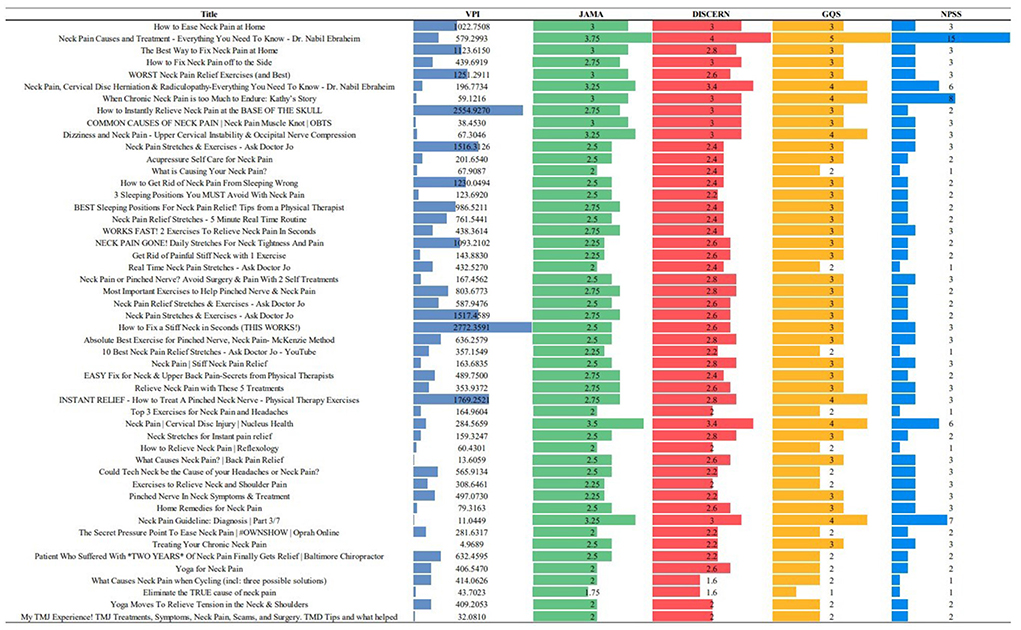
Figure 1. The video title, views per day, VPI, JAMA score, DISCERN, and GQS of the 50 videos are listed.
Topics and uploading sources
The included videos are categorized by upload sources and contents covered therein. Non-physician video sources accounted for the largest share (19/50, 38%), followed by academic sources (8/50, 16%), commercial sources (7/50, 14%), medical sources (6/50, 12%), individual sources (5/50, 10%) and physicians (5/50, 10%) (Figure 2).
Among all contents, exercise training was the most frequently covered (20/50, 40%), followed by information about disease (11/50, 22%), non-surgical treatment (7/50, 14%), advertisement (7/50, 14%), and patient experience (5/50, 10%) (Figure 3).
Information reliability and quality
The videos had a mean JAMA score of 2.56 (SD = 0.43), DISCERN of 2.55 (SD = 0.44), GQS of 2.86 (SD = 0.72), and NPSS of 2.90 (SD = 2.23). The reviewers had excellent agreement for the JAMA score (ICC, 0.909; 95% confidence interval, 0.846–0.947), DISCERN score (ICC, 0.923; 95% confidence interval, 0.858–0.958), GQS score (ICC, 0.927; 95% confidence interval, 0.876–0.958), and NPSS score (ICC, 0.939; 95% confidence interval, 0.895–0.965).
Additionally, between-group effects were calculated according to their upload source and contents. Significant differences between the uploading sources were observed for VPI (P = 0.012), JAMA (P < 0.0001), DISCERN (P < 0.0001), GQS (P = 0.001), and NPSS (P = 0.007), with videos from the academic group having the highest VPI, JAMA score, DISCERN, GQS, and NPSS. However, the VPI (P = 0.395), JAMA (P = 0.564), DISCERN (P = 0.869), GQS (P = 0.467), and NPSS (P = 0.329) did not statistically differ between the groups based on video content (Table 5).
Correlation analysis for factors influencing JAMA, DISCERN, GQS, and NPSS scores
In the total score correlation evaluation, the positive correlation between JAMA and discern was 84.3% (p < 0.0001), the positive correlation between JAMA and GQS was 87.3% (p < 0.0001), the positive correlation was 72.3% the percentage between JAMA and NPSS (p < 0.0001), the positive correlation between DISCERN and GQS was 84.3% (p < 0.0001), the positive correlation between DISCERN and NPSS was 72.0% (p < 0.0001), and the positive correlation between GQS and NPSs was 73.7% (p < 0.0001). However, there existed no significant correlation between the total VPI and the other four scores (Table 6).
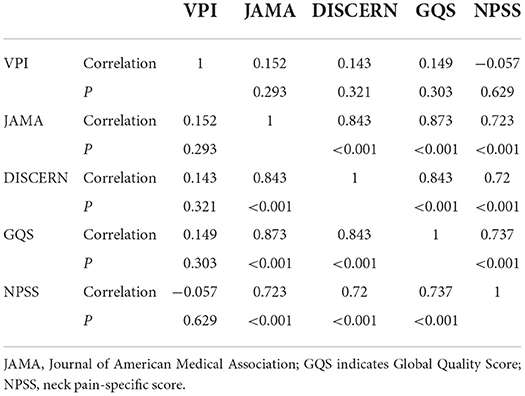
Table 6. Spearman correlation analysis was applied to assess the correlation between JAMA, GQS, DISCERN, NPSS, and VPI.
Multiple linear regression analysis suggested that a higher JAMA score was closely related with a higher probability of an academic (P < 0.0001), physician (P = 0.002), non-physician (P = 0.002) or medical (P = 0.002) upload source compared with an individual upload source. A higher DISECRN was closely related with a higher probability of an academic (P < 0.0001), physician (P = 0.005), non-physician (P = 0.006) or medical (P = 0.006) upload source than of an individual upload source. A higher GQS was closely related with academic (P < 0.0001), physician (P = 0.006), non-physician (P = 0.001) or medical (P = 0.003) upload sources than individuals upload sources. A higher NPSS was more associated with academic (P = 0.001) upload sources than with individual upload sources (Table 7).
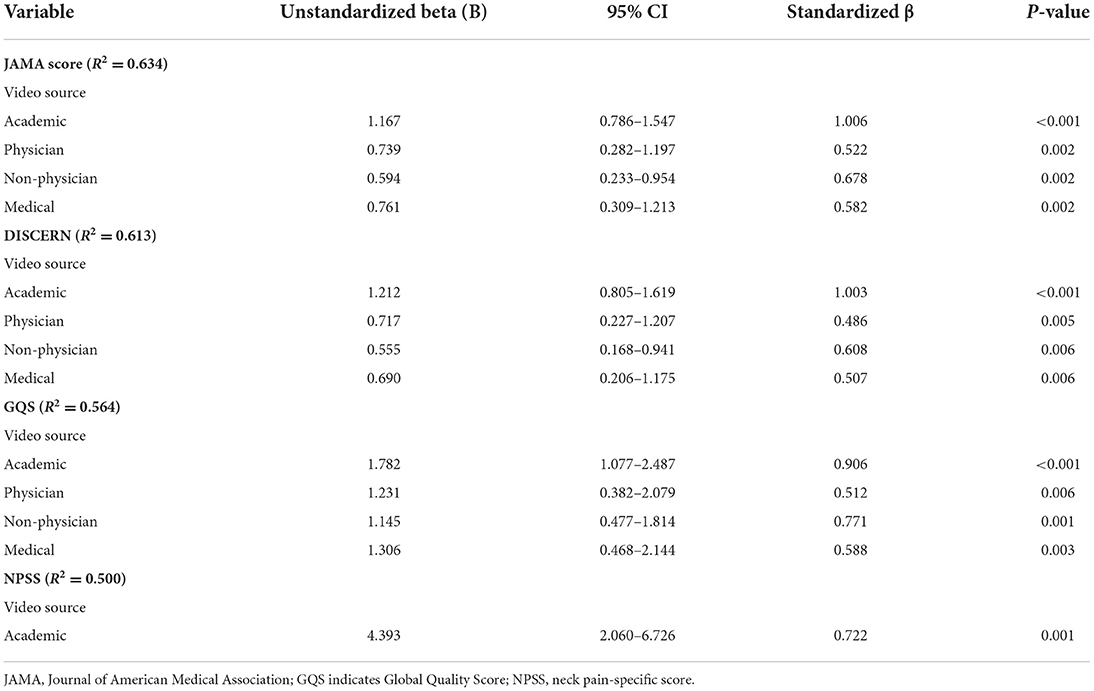
Table 7. Multiple linear regression analysis of correlations between video characteristics and the JAMA score, DISCERN, GQS, and NPSS.
Discussion
Motivation and meaning of this study
Several factors piqued our interest in carrying out this work. The paramount reason is the ever-increasing number of patients coming to our outpatient clinic complaining of neck pain. Numerous studies have shown that neck pain is related to a lack of physical exercise (41, 42). Various restrictions during the epidemic have reduced activity and increased sedentary behavior (43), resulting in a significant increase in the number of neck pain patients. Second, many patients have conducted online research before visiting our clinic, and the information obtained sometimes contradicts the professional opinion of the doctor. With the internet penetration rate exceeding 50% worldwide (28), the internet and its online video repositories have increasingly been utilized as a source of health education for patients about a variety of medical conditions. However, the quality, reliability and scientific justification of the contained information remains unclear, given that the video content or uploaded source have not been assessed through peer review processes or minimum health-related standards. Thus, patients with neck pain may be exposed to inaccurate, incomplete even misleading information prior to seeking medical attention, making it quite necessary to be aware of the reliability and quality of education available to patients posted on YouTube. Since we orthopedic surgeons do not have the authority to review, edit or modify videos uploaded on YouTube or other sources, it is imperative that we at least understand how the Internet influences the patients concerning the commonly encountered diseases at the clinic.
Neck pain requires prompt diagnosis and treatment, which highlights the importance of accurate and comprehensive health education. In general, history and physical examination not only provide crucial clues as to whether the pain is neurologic or mechanical, but can also be used to identify “red flags” that may indicate serious pathology, such as cervical spondylotic myelopathy, atlantoaxial subluxation, and tumor metastasis. Magnetic resonance imaging is characterized by a high incidence of abnormalities in asymptomatic individuals, and should be considered in cases involving progressive neurologic deficits, in pain refractory to conventional treatment, and when referring patients for interventional treatment (37). For the treatment of neck pain, there are consistent weak or moderate intensity recommendations: advice and education, referral to exercise therapy/programs, oral analgesics and topical medications, plus psychotherapy, surgery, or multidisciplinary treatment for specific subgroups (11, 44, 45). Given the current epidemic, this is more important than ever, as patients with inadequate or inappropriate access to medical information about neck pain can miss out on individualized diagnosis and treatment for their condition, which can severely exacerbate or delay their conditions.
Principal findings
To the best of our knowledge, there currently exist no studies evaluating the reliability and quality of YouTube videos providing medical information to patients with neck pain and identified factors associated with the overall video quality or reliability. According to our analysis, the reliability and quality of YouTube videos pertaining to neck pain were low, which is in consistent with the results of previous studies on YouTube videos within orthopedics. Erdem et al. (28) determined that the mean JAMA score (maximum of 4 points), GQS (maximum of 5 points), and kyphosis-specific score (maximum of 32 points) were 1.34, 1.68, and 3.02, respectively. MacLeod et al. (22) conducted YouTube-based research for Femoroacetabular Impingement information and found that the mean video quality assessment scores were 3.1 for diagnosis and 2.9 for treatment (maximum score of 16 points). Cassidy et al. (46) determined that the mean JAMA score and anterior cruciate ligament-specific score (maximum of 25 points) were 2.4 and 5.5, respectively. Hornung et al. (47) determined that the mean JAMA, GQS, and low back pain-specific score (maximum of 15 points) were 2.25, 2.29, and 3.83, respectively. Together, these data suggested that the reliability and quality of the YouTube videos on orthopedic disorders were low.
Even so, some studies conducted on YouTube found its reliability and quality to be high. First of all, our study is irrelevant to the subject of the above studies, this leads to different videos being retrieved on YouTube, which further leads to different details such as video upload sources. In the study conducted by Akyol Onder et al. (48) regarding dialysis, 32.6% (14/43) of videos were uploaded by universities/governments/professional societies. Ng et al. (49) searched on YouTube for information about lupus erythematosus and 49.7% (91/183) of videos were uploaded by professionals. Langford et al. (50) conducted the YouTube-based analysis for Spinal Cord Stimulation and 53.4% (55/103) were uploaded by hospitals, group practice or physician. However, in our study, only 16% (8/50) of videos were uploaded by professionals. Considering that professionals upload more high-quality videos (31, 51) and that most videos are uploaded by unqualified individuals and are not peer-reviewed, this may be the major reason why our study contradicted the minority of studies. In addition, in our study, particularly striking was the average NPSS of 2.90, with a maximum score of 18, highlighting the dilemma of the current video's lack of discussion of information specific to neck pain.
Once patients have researched their disease prior to their clinic visit, it is very challenging to properly inform and convince misguided patients to receive proper treatment and free them from prejudgment. Therefore, as clinicians, it is necessary for us to evaluate video quality and explore the factors that affect video quality to better guide patients on how to correctly find videos on the Internet that may be useful for their disease.
Despite the low reliability and educational quality of YouTube videos, those uploaded by academics scored significantly higher than those of other video sources. In addition, multiple linear regression analysis also supported that ownership (academic uploaders) is an important influencing factors that can be used to improve the reliability and quality of YouTube videos. This finding is consistent with those of other studies (31, 51). This may be explained by the fact that experts have more specialized knowledge, as well as the list of additional sources of information attached. When academic uploaders produce a video concerning neck pain, they should exert more effort to provide equalized information, list extra sources of information, and refer areas of uncertainty.
In contrast, the reliability and educational quality did not differ significantly among the video contents. The content of the videos included in the study mainly covered exercise training, information about disease, patient experience, and non-surgical and advertisement information. Most videos contain only 1 or 2 of the above categories. Particularly striking is the mean NPSS of 2.90, as the maximum possible score is 18 points, highlighting the dilemma that the current videos lack of discussion of neck pain-specific information. With the lack of availability of in-person medical information exchange during the COVID-19 pandemic, patients suffering from neck pain are at risk of insufficient or inadequate information if they decide to educate themselves regarding neck pain.
In our study, the popularity of videos was not significantly related to their quality or reliability, which was in agreement with previous research (27, 31). According to these findings, we can infer that the patients may find it challenging to differentiate between useful information and misleading information. Actually, of the 50 videos we included, some videos contained misleading information. These videos were often touted as “quick neck pain relief” when in fact they contained only simple neck exercises. This could cause some patients with severe diseases (e.g., spinal cervical spondylosis, neck trauma) to underestimate their condition, which could affect the diagnosis and treatment of the disease. This is more important than ever given the current situation, where insufficient or inappropriate access to medical information about neck pain can severely exacerbate or delay a patient's symptoms. Therefore, effective and prompt measures should be adopted to reduce inaccurate, incomplete (even harmful) information on YouTube platform.
Challenges and solutions
Neck pain occupies one of the top five chronic pain conditions according to prevalence and years of disability, placing a considerable burden on individuals and the social economy. While most acute episodes resolve spontaneously, more than 30% of patients experience mild symptoms or relapse more than a year later, with genetic and psychosocial factors being persistent risk factors (11). To make matters worse, management of neck pain has been severely affected during the COVID-19 pandemic (18, 52–55). Given the explosive growth of the Internet as a fast and wide source of medical information in all areas of life, an increasing number of orthopedic patients have searched for medical information on YouTube, while the overall quality and reliability of relevant videos is poor. Most videos are uploaded by unqualified individuals and are not peer-reviewed, leading to the dissemination of inaccurate and low-quality data. Many studies have reported that a high percentage of videos posted on YouTube even provide misleading information (50, 51). The alarming state of YouTube platforms can easily lead to misinterpretation between patients and their doctors, hindering patients from proper selection and timely treatment, which may worsen their conditions.
A previous article recommended that a process of peer review during submission might be an possible solution (56), but the process not only requires experts and scholars to review but also consumes considerable time. Consistent with the conclusions of many previous studies (31, 51), our study demonstrated that YouTube videos uploaded from academics had a significantly higher quality and reliability than those posted by individuals. Hence, these professionals from academic groups should exhaust their expertise and provide patients with high-quality videos on YouTube as a source of information. Referring to the JAMA and DISCERN scoring scale, another feasible suggestion would be to ask video uploaders to provide their credentials or affiliations, state the references and sources for content and mention areas of uncertainty.
In addition, the perception and understanding of the video will depend on the user's level of knowledge of the subject. In our study, we aimed to assess the quality and reliability of the medical information shared on YouTube regarding neck pain with internationally recognized evaluation standards and to identify factors associated with the overall video quality or reliability. According to our results, YouTube videos pertaining to neck pain contain low quality, low reliability, and incomplete information. Even the videos from academics or physicians are inadequate in terms of quality and instructiveness. Therefore, there is a need not only to improve the background of the viewer's expertise or to make the expert's videos readable through health education, but most urgently to improve the quality and reliability of the videos and the accuracy and comprehensiveness of the information they contain. Professional associations or credible healthcare organizations should introduce educational videos on relevant diseases that will meet all JAMA criteria, have a GQS of 4 or higher, contain adequate, accurate, and comprehensive information about the patient presentation (symptoms and patients population), evaluation and diagnosis, and treatment alternatives of the disease, and about its possible results and complications, and will not negatively impact the clinician-patient relationship (28).
Limitations
There are a few inevitable limitations in our study. First, the assessment scoring systems that we used (NPSS) are subjective and unvalidated. The NPSS included comprehensive contents of neck pain, while almost all YouTube videos focused on a specific topic and have a short running time of ~10 min or less. As such, it tended to be intractable to present all NPSS checklists. Nonetheless, considering that existing scoring criteria only non-specifically rate video quality rather than video content and no validated scales existed for assessing the content of video information, we designed quality assessment checklists based on a comprehensive review of relevant expert discussion and neck pain literature. Correlation analysis showed that NPSS was significantly correlated with JAMA, DISCERN, or GQS, which suggested that NPSS has a good application prospect. Second, we searched YouTube for the top 50 videos for “neck pain” by relevant. Actually, a default “relevance” sorting option was adopted by many studies when evaluating the reliability and quality of YouTube videos providing medical information to patients (22, 29, 32, 57–60). The default ranking option—“Relevance”—was the most commonly used option in the YouTube ranking algorithm (relevance, upload date, number of views, rating) (61, 62). This search strategy may miss some videos that have low views or hits but may be of high quality, but it is a practical way for casual users of YouTube to obtain information. Third, the characteristics of videos, such as the number of dislikes and comments, are constantly being updated. Thus, these video data are accurate only on the date of the search. Fourth, given that YouTube is the only online video archive that has been queried to evaluate educational content about neck pain, there is also the possibility of some selection bias. However, given that YouTube occupies the most influential and popular video hosting platform, we believe that using YouTube is an appropriate and clinically relevant platform as many patients access. Fifth, in retrieving the video, we did not use other synonyms for neck pain for the analysis. The reason for this was not only that we referred to the majority of the literature (27, 29, 63–65), but also such an analysis (use other synonyms) would divert our study from the intended course of evaluating the quality of information on a medical illness retrieved from YouTube and that the results returned upon searching with common keywords were mostly videos either not related to neck pain (28). Although our search strategy may miss some videos that were less “popular,” this strategy was the actual method by which casual YouTube users obtained information. Finally, we used the search item “neck pain” on YouTube and all videos were in English, making the conclusion cannot be applied to other languages.
Conclusion
In particular, the current COVID-19 pandemic has highlighted the potential benefits of web-based education for patients suffering from chronic diseases. In light of its high popularity and ease to access, YouTube can be utilized to provide patients with timely medical information and tutorials for neck pain. However, this study suggested that videos concerning neck pain posted on YouTube showed low reliability and quality. The reliability or quality of the video is significantly related to the academic upload source. Video popularity was not associated with video reliability or quality, which suggests that popular videos do not guarantee good content quality. To ensure the dissemination of useful information, YouTube videos must be posted by academics to upload sources and strive to provide high-quality videos that aid in patient diagnosis and treatment.
Data availability statement
The original contributions presented in the study are included in the article/Supplementary material, further inquiries can be directed to the corresponding author/s.
Author contributions
XZ and HL participated in the conceptualization of the paper. XZ and YY conducted the data searches on the internet. Y-WS, K-RZ, and L-TM extracted relevant and analysis data. CD, B-YW, YM, and HL critically reviewed the manuscript for important intellectual content. XZ structured and wrote the paper. All authors read and approved the final manuscript.
Funding
This study was supported by the National Natural Science Foundation of China (82172522), Sichuan Province Science and Technology Support Program of China (Nos. 2020YFS0089 and 2020YFS0077), Postdoctor Research Project, West China Hospital, Sichuan University (No. 2019HXBH063), and the Postdoctoral Science Foundation of China (No. 2020M673240).
Conflict of interest
The authors declare that the research was conducted in the absence of any commercial or financial relationships that could be construed as a potential conflict of interest.
Publisher's note
All claims expressed in this article are solely those of the authors and do not necessarily represent those of their affiliated organizations, or those of the publisher, the editors and the reviewers. Any product that may be evaluated in this article, or claim that may be made by its manufacturer, is not guaranteed or endorsed by the publisher.
Supplementary material
The Supplementary Material for this article can be found online at: https://www.frontiersin.org/articles/10.3389/fpubh.2022.972348/full#supplementary-material
Raw scores of JAMA score, DISCERN, and GQS are listed in Supplementary File 1.
References
1. Damasceno GM, Ferreira AS, Nogueira LAC, Reis FJJ, Andrade ICS, Meziat-Filho N. Text neck and neck pain in 18–21-year-old young adults. Eur Spine J. (2018) 27:1249–54. doi: 10.1007/s00586-017-5444-5
2. Hoy DG, Protani M, De R, Buchbinder R. The epidemiology of neck pain. Best Pract Res Clin Rheumatol. (2010) 24:783–92. doi: 10.1016/j.berh.2011.01.019
3. Hurwitz EL, Randhawa K, Yu H, Côté P, Haldeman S. The Global Spine Care Initiative: a summary of the global burden of low back and neck pain studies. Eur Spine J. (2018) 27(Suppl. 6):796–801. doi: 10.1007/s00586-017-5432-9
4. Peng B, DePalma MJ. Cervical disc degeneration and neck pain. J Pain Res. (2018) 11:2853–7. doi: 10.2147/JPR.S180018
5. Popescu A, Lee H. Neck pain and lower back pain. Med Clin North Am. (2020) 104:279–92. doi: 10.1016/j.mcna.2019.11.003
6. Fejer R, Kyvik KO, Hartvigsen J. The prevalence of neck pain in the world population: a systematic critical review of the literature. Eur Spine J. (2006) 15:834–48. doi: 10.1007/s00586-004-0864-4
7. Safiri S, Kolahi AA, Hoy D, Buchbinder R, Mansournia MA, Bettampadi D, et al. Global, regional, and national burden of neck pain in the general population, 1990–2017: systematic analysis of the Global Burden of Disease Study 2017. BMJ. (2020) 368:m791. doi: 10.1136/bmj.m791
8. Hogg-Johnson S, van der Velde G, Carroll LJ, Holm LW, Cassidy JD, Guzman J, et al. The burden and determinants of neck pain in the general population: results of the Bone and Joint Decade 2000–2010 Task Force on Neck Pain and Its Associated Disorders. Spine. (2008) 33(4 Suppl.):S39–51. doi: 10.1097/BRS.0b013e31816454c8
9. Fernández-de-las-Peñas C, Hernández-Barrera V, Alonso-Blanco C, Palacios-Ceña D, Carrasco-Garrido P, Jiménez-Sánchez S, et al. Prevalence of neck and low back pain in community-dwelling adults in Spain: a population-based national study. Spine. (2011) 36:E213–9. doi: 10.1097/BRS.0b013e3181d952c2
10. Kazeminasab S, Nejadghaderi SA, Amiri P, Pourfathi H, Araj-Khodaei M, Sullman MJM, et al. Neck pain: global epidemiology, trends and risk factors. BMC Musculoskelet Disord. (2022) 23:26. doi: 10.1186/s12891-021-04957-4
11. Cohen SP, Hooten WM. Advances in the diagnosis and management of neck pain. BMJ. (2017) 358:j3221. doi: 10.1136/bmj.j3221
12. Friedman MH, Nelson AJ Jr. Head and neck pain review: traditional and new perspectives. J Orthopaed Sports Phys Ther. (1996) 24:268–78. doi: 10.2519/jospt.1996.24.4.268
13. May S, Gardiner E, Young S, Klaber-Moffett J. Predictor variables for a positive long-term functional outcome in patients with acute and chronic neck and back pain treated with a McKenzie approach: a secondary analysis. J Manual Manipul Ther. (2008) 16:155–60. doi: 10.1179/jmt.2008.16.3.155
14. Peterson C, Bolton J, Humphreys BK. Predictors of outcome in neck pain patients undergoing chiropractic care: comparison of acute and chronic patients. Chiropract Manual Ther. (2012) 20:27. doi: 10.1186/2045-709X-20-27
15. Falvey JR, Krafft C, Kornetti D. The essential role of home- and community-based physical therapists during the COVID-19 pandemic. Phys Ther. (2020) 100:1058–61. doi: 10.1093/ptj/pzaa069
16. Minghelli B, Soares A, Guerreiro A, Ribeiro A, Cabrita C, Vitoria C, et al. Physiotherapy services in the face of a pandemic. Rev Assoc Med Brasil. (2020) 66:491–7. doi: 10.1590/1806-9282.66.4.491
17. Gitkind AI, Levin S, Dohle C, Herbold J, Thomas M, Oh-Park M, et al. Redefining pathways into acute rehabilitation during the COVID-19 crisis. PM & R. (2020) 12:837–41. doi: 10.1002/pmrj.12392
18. Lee B, Yang KC, Kaminski P, Peng S, Odabas M, Gupta S, et al. Substitution of nonpharmacologic therapy with opioid prescribing for pain during the COVID-19 pandemic. JAMA Netw Open. (2021) 4:e2138453. doi: 10.1001/jamanetworkopen.2021.38453
19. Finney Rutten LJ, Blake KD, Greenberg-Worisek AJ, Allen SV, Moser RP, Hesse BW. Online health information seeking among US adults: measuring progress toward a healthy people 2020objective. Public Health Rep. (2019) 134:617–25. doi: 10.1177/0033354919874074
20. Baker JF, Devitt BM, Kiely PD, Green J, Mulhall KJ, Synnott KA, et al. Prevalence of Internet use amongst an elective spinal surgery outpatient population. Eur Spine J. (2010) 19:1776–9. doi: 10.1007/s00586-010-1377-y
21. Springer B, Bechler U, Koller U, Windhager R, Waldstein W. Online videos provide poor information quality, reliability, and accuracy regarding rehabilitation and return to sport after anterior cruciate ligament reconstruction. Arthroscopy. (2020) 36:3037–47. doi: 10.1016/j.arthro.2020.07.013
22. MacLeod MG, Hoppe DJ, Simunovic N, Bhandari M, Philippon MJ, Ayeni OR. YouTube as an information source for femoroacetabular impingement: a systematic review of video content. Arthroscopy. (2015) 31:136–42. doi: 10.1016/j.arthro.2014.06.009
23. Koller U, Waldstein W, Schatz KD, Windhager R. YouTube provides irrelevant information for the diagnosis and treatment of hip arthritis. Int Orthopaed. (2016) 40:1995–2002. doi: 10.1007/s00264-016-3174-7
24. Kocyigit BF, Nacitarhan V, Koca TT, Berk E. YouTube as a source of patient information for ankylosing spondylitis exercises. Clin Rheumatol. (2019) 38:1747–51. doi: 10.1007/s10067-018-04413-0
25. Madathil KC, Rivera-Rodriguez AJ, Greenstein JS, Gramopadhye AK. Healthcare information on YouTube: a systematic review. Health Inform J. (2015) 21:173–94. doi: 10.1177/1460458213512220
26. Lewis SP, Heath NL, Sornberger MJ, Arbuthnott AE. Helpful or harmful? An examination of viewers' responses to nonsuicidal self-injury videos on YouTube. J Adolesc Health. (2012) 51:380–5. doi: 10.1016/j.jadohealth.2012.01.013
27. Kunze KN, Krivicich LM, Verma NN, Chahla J. Quality of online video resources concerning patient education for the meniscus: a youtube-based quality-control study. Arthroscopy. (2020) 36:233–8. doi: 10.1016/j.arthro.2019.07.033
28. Erdem MN, Karaca S. Evaluating the accuracy and quality of the information in Kyphosis videos shared on YouTube. Spine. (2018) 43:E1334–9. doi: 10.1097/BRS.0000000000002691
29. Staunton PF, Baker JF, Green J, Devitt A. Online curves: a quality analysis of scoliosis videos on YouTube. Spine. (2015) 40:1857–61. doi: 10.1097/BRS.0000000000001137
30. Morahan-Martin JM. How internet users find, evaluate, and use online health information: a cross-cultural review. Cyberpsychol Behav. (2004) 7:497–510. doi: 10.1089/cpb.2004.7.497
31. Kwak D, Park JW, Won Y, Kwon Y, Lee JI. Quality and reliability evaluation of online videos on carpal tunnel syndrome: a YouTube video-based study. BMJ Open. (2022) 12:e059239. doi: 10.1136/bmjopen-2021-059239
32. Stogowski P, Antkowiak L, Trzciński R, Rogalska M, Dułak NA, Anuszkiewicz K, et al. Content quality and audience engagement analysis of online videos for anterior lumbar interbody fusion. World Neurosurg. (2022) 160:e636–42. doi: 10.1016/j.wneu.2022.01.102
33. Silberg WM, Lundberg GD, Musacchio RA. Assessing, controlling, and assuring the quality of medical information on the Internet: caveant lector et viewor–Let the reader and viewer beware. JAMA. (1997) 277:1244–5. doi: 10.1001/jama.1997.03540390074039
34. Singh AG, Singh S, Singh PP. YouTube for information on rheumatoid arthritis–a wakeup call? J Rheumatol. (2012) 39:899–903. doi: 10.3899/jrheum.111114
35. Viljanen M, Malmivaara A, Uitti J, Rinne M, Palmroos P, Laippala P. Effectiveness of dynamic muscle training, relaxation training, or ordinary activity for chronic neck pain: randomised controlled trial. BMJ. (2003) 327:475. doi: 10.1136/bmj.327.7413.475
36. Carroll LJ, Hogg-Johnson S, van der Velde G, Haldeman S, Holm LW, Carragee EJ, et al. Course and prognostic factors for neck pain in the general population: results of the Bone and Joint Decade 2000–2010 Task Force on Neck Pain and Its Associated Disorders. Spine. (2008) 33(4 Suppl.):S75–82. doi: 10.1097/BRS.0b013e31816445be
37. Cohen SP. Epidemiology, diagnosis, and treatment of neck pain. Mayo Clin Proc. (2015) 90:284–99. doi: 10.1016/j.mayocp.2014.09.008
38. Côté P, van der Velde G, Cassidy JD, Carroll LJ, Hogg-Johnson S, Holm LW, et al. The burden and determinants of neck pain in workers: results of the Bone and Joint Decade 2000–2010 Task Force on Neck Pain and Its Associated Disorders. Spine. (2008) 33(4 Suppl.):S60–74. doi: 10.1097/BRS.0b013e3181643ee4
39. Wieser ES, Wang JC. Surgery for neck pain. Neurosurgery. (2007) 60(1 Supp1. 1):S51–6. doi: 10.1227/01.NEU.0000215376.14375.D
40. Koo TK, Li MY. A guideline of selecting and reporting intraclass correlation coefficients for reliability research. J Chiropract Med. (2016) 15:155–63. doi: 10.1016/j.jcm.2016.02.012
41. Cimmino MA, Ferrone C, Cutolo M. Epidemiology of chronic musculoskeletal pain. Best Pract Res Clin Rheumatol. (2011) 25:173–83. doi: 10.1016/j.berh.2010.01.012
42. Hush JM, Michaleff Z, Maher CG, Refshauge K. Individual, physical and psychological risk factors for neck pain in Australian office workers: a 1-year longitudinal study. Eur Spine J. (2009) 18:1532–40. doi: 10.1007/s00586-009-1011-z
43. Tremblay MS, Aubert S, Barnes JD, Saunders TJ, Carson V, Latimer-Cheung AE, et al. Sedentary Behavior Research Network (SBRN) - terminology consensus project process and outcome. Int J Behav Nutr Phys Activity. (2017) 14:75. doi: 10.1186/s12966-017-0525-8
44. Corp N, Mansell G, Stynes S, Wynne-Jones G, Morsø L, Hill JC, et al. Evidence-based treatment recommendations for neck and low back pain across Europe: a systematic review of guidelines. Eur J Pain. (2021) 25:275–95. doi: 10.1002/ejp.1679
45. Wong JJ, Shearer HM, Mior S, Jacobs C, Côté P, Randhawa K, et al. Are manual therapies, passive physical modalities, or acupuncture effective for the management of patients with whiplash-associated disorders or neck pain and associated disorders? An update of the Bone and Joint Decade Task Force on Neck Pain and Its Associated Disorders by the OPTIMa collaboration. Spine J. (2016) 16:1598–630. doi: 10.1016/j.spinee.2015.08.024
46. Cassidy JT, Fitzgerald E, Cassidy ES, Cleary M, Byrne DP, Devitt BM, et al. YouTube provides poor information regarding anterior cruciate ligament injury and reconstruction. Knee Surg Sports Traumatol Arthroscopy. (2018) 26:840–5. doi: 10.1007/s00167-017-4514-x
47. Hornung AL, Rudisill SS, Suleiman RW, Siyaji ZK, Sood S, Siddiqui S, et al. Low back pain: what is the role of YouTube content in patient education? J Orthopaed Res. (2022) 40:901–8. doi: 10.1002/jor.25104
48. Akyol Onder EA-O, Ertan PA-O. YouTube as a source of information on COVID-19 and dialysis. LID (2022) (1744–9987 (Electronic)). doi: 10.1111/1744-9987.13801
49. Ng CA-O, Lim GRS, Fong WA-O. Quality of English-language videos on YouTube as a source of information on systemic lupus erythematosus. (2020) (1756-185X (Electronic)). doi: 10.1111/1756-185X.13852
50. Langford B, Hooten WM, D'Souza S, Moeschler S, D'Souza RS. YouTube as a source of medical information about spinal cord stimulation. Neuromodulation. (2021) 24:156–61. doi: 10.1111/ner.13303
51. Pan P, Yu C, Li T, Zhou X, Dai T, Tian H, et al. Xigua video as a source of information on breast cancer: content analysis. J Med Internet Res. (2020) 22:e19668. doi: 10.2196/19668
52. Fiani B, Siddiqi I, Lee SC, Dhillon L. Telerehabilitation: development, application, and need for increased usage in the COVID-19 era for patients with spinal pathology. Cureus. (2020) 12:e10563. doi: 10.7759/cureus.10563
53. Khosrokiani Z, Letafatkar A, Hadadnezhad M, Sokhanguei Y. Comparison the effect of pain neuroscience and pain biomechanics education on neck pain and fear of movement in patients with chronic nonspecific neck pain during the COVID-19 pandemic. Pain Ther. (2022) 11:601–11. doi: 10.1007/s40122-022-00371-3
54. Radulović AH, Žaja R, Milošević M, Radulović B, Luketić I, BoŽić T. Work from home and musculoskeletal pain in telecommunications workers during COVID-19 pandemic: a pilot study. Arhiv za higijenu rada i toksikologiju. (2021) 72:232–9. doi: 10.2478/aiht-2021-72-3559
55. Sekiguchi T, Hagiwara Y, Yabe Y, Sugawara Y, Tsuji I, Itoi E. Association of decreased physical activity due to the COVID-19 pandemic with new-onset neck pain in survivors of the Great East Japan Earthquake: a prospective cohort study. BMJ Open. (2021) 11:e051751. doi: 10.1136/bmjopen-2021-051751
56. Kaval ME, Kandemir Demirci G, Atesci AA, Sarsar F, Dindaroglu F, Güneri P, et al. YouTube™ as an information source for regenerative endodontic treatment procedures: quality and content analysis. Int J Med Inform. (2022) 161:104732. doi: 10.1016/j.ijmedinf.2022.104732
57. Ahuja K, Aggarwal P, Sareen JR, Mohindru S, Kandwal P. Comprehensiveness and reliability of YouTube as an information portal for lumbar spinal fusion: a systematic review of video content. Int J Spine Surg. (2021) 15:179–85. doi: 10.14444/8023
58. Castillo J, Zhu K, Gray L, Sachse S, Berra A, Belfort MA, et al. YouTube as a source of patient information regarding placenta accreta spectrum. Am J Perinatol. (2021) 222:S727–8. doi: 10.1055/s-0041-1732453
59. Abul-Fottouh D, Song MY, Gruzd A. Examining algorithmic biases in YouTube's recommendations of vaccine videos. Int J Med Inform. (2020) 140:104175. doi: 10.1016/j.ijmedinf.2020.104175
60. Sahin A, Sahin M, Türkcü FM. YouTube as a source of information in retinopathy of prematurity. Irish J Med Sci. (2019) 188:613–7. doi: 10.1007/s11845-018-1902-2
61. Zengin O, Onder ME. Educational quality of YouTube videos on musculoskeletal ultrasound. Clin Rheumatol. (2021) 40:4243–51. doi: 10.1007/s10067-021-05793-6
62. Li M, Yan S, Yang D, Li B, Cui W. YouTube™ as a source of information on food poisoning. BMC Public Health. (2019) 19:952. doi: 10.1186/s12889-019-7297-9
63. Lena Y, Dindaroglu F. Lingual orthodontic treatment: a YouTube™ video analysis. Angle Orthodontist. (2018) 88:208–14. doi: 10.2319/090717-602.1
64. Morra S, Collà Ruvolo C, Napolitano L, La Rocca R, Celentano G, Califano G, et al. YouTube(TM) as a source of information on bladder pain syndrome: a contemporary analysis. Neurourol Urodyn. (2022) 41:237–45. doi: 10.1002/nau.24802
Keywords: neck pain, YouTube, education, content analysis, quality-control study
Citation: Zhang X, Yang Y, Shen Y-W, Zhang K-R, Ma L-T, Ding C, Wang B-Y, Meng Y and Liu H (2022) Quality of online video resources concerning patient education for neck pain: A YouTube-based quality-control study. Front. Public Health 10:972348. doi: 10.3389/fpubh.2022.972348
Received: 18 June 2022; Accepted: 24 August 2022;
Published: 21 September 2022.
Edited by:
Xuan Li, University of Mississippi Medical Center, United StatesReviewed by:
Mustafa Erkut Onder, Aksaray University, TurkeyJuan Antonio Ruiz Roca, University of Murcia, Spain
Copyright © 2022 Zhang, Yang, Shen, Zhang, Ma, Ding, Wang, Meng and Liu. This is an open-access article distributed under the terms of the Creative Commons Attribution License (CC BY). The use, distribution or reproduction in other forums is permitted, provided the original author(s) and the copyright owner(s) are credited and that the original publication in this journal is cited, in accordance with accepted academic practice. No use, distribution or reproduction is permitted which does not comply with these terms.
*Correspondence: Hao Liu, bGl1aGFvNjMwNEAxMjYuY29t
†These authors have contributed equally to this work
 Xiang Zhang†
Xiang Zhang† Yi-Wei Shen
Yi-Wei Shen Hao Liu
Hao Liu